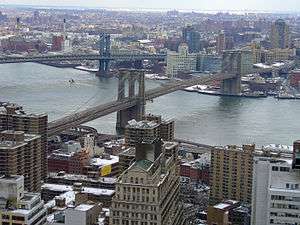John A. Roebling
John Augustus Roebling (born Johann August Röbling; June 12, 1806 – July 22, 1869) was a German-born American civil engineer.[1] He designed and built wire rope suspension bridges, in particular the Brooklyn Bridge, which has been designated as a National Historic Landmark and a National Historic Civil Engineering Landmark.
John A. Roebling | |
|---|---|
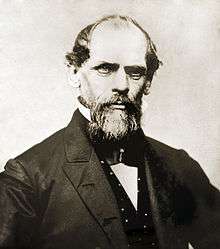 circa 1866 | |
| Born | Johann August Röbling June 12, 1806 |
| Died | July 22, 1869 (aged 63) |
| Nationality | Prussian |
| Known for | Brooklyn Bridge Covington-Cincinnati Bridge |
Education
John was born to Friederike Dorothea Röbling (née Muelleren) and Christoph Polykarpus Röbling. Recognizing his intelligence at a young age, Roebling's mother arranged for him to be tutored in mathematics and science at Erfurt by Ephraim Salomon Unger.[2] He went to Erfurt when he was 15. In 1824 he passed his Surveyor's examination and returned home for a year. In 1824 he enrolled for two semesters at the Bauakademie in Berlin, where he studied architecture and engineering under Martin Friedrich Rabe (1765–1856), bridge construction and foundation construction under Johann Friedrich Dietlein (1782–1837), hydraulics under Johann Albert Eytelwein (1764–1848), and languages. Roebling also attended lectures of the philosopher Georg Wilhelm Friedrich Hegel. Roebling developed an interest in natural philosophy and many years later he worked on a 1000-page treatise about his own concepts of the universe.[3]
In 1825 Roebling got a government job at Arnsberg, Westphalia, working on military road building for four years. During this period he made sketches for suspension bridges. In 1829 he returned to his home to work out his final thesis and prepare for his second engineer examination. For unknown reasons, he never took the examination.[4]
Career
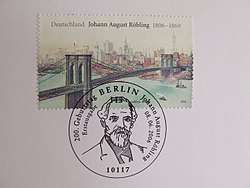
On May 22, 1831, Roebling left Prussia with his brother Carl and Johann Adolphus Etzler, who believed in a technological utopia, and a group of emigrants. Engineers had difficulty advancing and achieving economic mobility in Prussian society. The Napoleonic Wars, which lasted until 1815, had suppressed investment in infrastructure. During this period, Prussia had political unrest, as authoritarian governments took the places of democratic ones. Etzler had ideas about creating a utopia in the United States, but disputes arose en route, and the group split up. John and Carl purchased 1582 acres (6.4 km²) of land on October 28, 1831, in Butler County, Pennsylvania[5] with the intent to establish a German settlement, to be called Saxonburg. Most of the other settlers had remained with Etzler. The John Roebling House at Saxonburg was listed on the National Register of Historic Places in 1976.[6]
When the Roeblings and others arrived, the United States was in the later stages of an economic boom, which ended in the Panic of 1837. Farmers were deeply affected by it. By the 1840s, many Americans believed in the nation's manifest destiny to extend its borders and achieve greatness. Transportation between eastern industrial hubs and frontier farming markets had become a matter of both national and popular interest. Many railway and transportation projects were underway near the site which Roebling chose for his colony, but instead of continuing in the engineering profession, he took up farming. After five years he married Johanna Herting, a tailor's daughter.
He found agrarian work unsatisfying, and the colony attracted very few settlers. In 1837, after the death of his brother Carl and the birth of his first child, Roebling returned to engineering as a vocation. He first worked on projects to improve river navigation and build canals. For three years, he conducted surveys for railway lines across the Allegheny Mountains, from Harrisburg to Pittsburgh, for the state of Pennsylvania.
In 1840 he wrote to suspension bridge designer Charles Ellet, Jr., offering to help with the design of a bridge near Philadelphia:[7]
The study of suspension bridges formed for the last few years of my residence in Europe my favourite occupation ... Let but a single bridge of the kind be put up in Philadelphia, exhibiting all the beautiful forms of the system to full advantage, and it needs no prophecy to foretell the effect which the novel and useful features will produce upon the intelligent minds of the Americans.
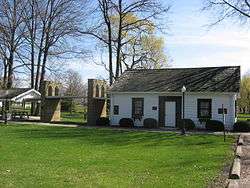
Roebling began producing wire rope at Saxonburg in 1841. At that time canal boats from Philadelphia were transported over the Allegheny Mountains on railroad cars in order to access waterways on the other side of the mountains, so that the boats could continue to Pittsburgh. The system of inclines and levels that moved the boats and conventional railroad cars was a state-owned enterprise, the Allegheny Portage Railroad. The railroad cars were pulled up and down the inclines by a long loop of thick hemp rope, up to 7 centimeters thick. The hemp ropes were expensive and had to be replaced frequently. Roebling remembered an article he had read about wire ropes. Soon after, he started developing a 7-strand wire rope at a ropewalk that he built on his farm.
In 1844 Roebling won a bid to replace the wooden canal aqueduct across the Allegheny River with the Allegheny Aqueduct. His design encompassed seven spans of 163 feet (50 m), each consisting of a wooden trunk to hold the water, supported by a continuous cable made of many parallel wires, wrapped tightly together, on each side of the trunk. He followed this innovation in 1845 by building a suspension bridge over the Monongahela River at Pittsburgh.
In 1848 Roebling undertook the construction of four suspension aqueducts on the Delaware and Hudson Canal. During this period, he moved to Trenton, New Jersey. In Trenton, Roebling built a large industrial complex for wire production for his growing company: John A. Roebling's Sons Company. This complex inspired the Trenton, New Jersey motto on Trenton's Lower Trenton Bridge: "Trenton Makes, the World Takes".
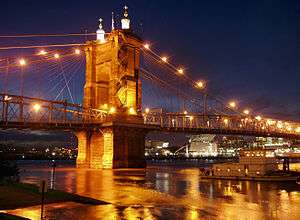
Roebling's next project, starting in 1851, was a railroad bridge connecting the New York Central and Great Western Railway of Canada over the Niagara River. Construction took four years. The bridge, with a clear span of 825 feet (251 m), was supported by four, ten-inch (25 cm) wire cables, and had two levels, one for vehicles and one for rail traffic.
While the Niagara bridge was being built, Roebling undertook a railway suspension bridge across the Kentucky River, which required a clear span of 1,224 feet (373 m). The anchorage and stone towers were completed, and the cable wire delivered along with the material for the superstructure, when the railway company became insolvent. The bridge construction was halted. It was later completed as the first cantilever bridge in the US, with a truss for carrying the railway track.
In 1859 Roebling completed another suspension bridge at Pittsburgh. Its total length was 1,030 feet (314m), consisting of two main spans of 344 feet (105 m) each, and two side spans of 171 feet (52 m) each.
The American Civil War brought a temporary halt to Roebling's work. However, in 1863 building resumed on a bridge over the Ohio River at Cincinnati, which he had started in 1856 and halted due to lack of financing; he finished this bridge in 1867. The Cincinnati-Covington Bridge, later named the John A. Roebling Suspension Bridge in his honor, was the world's longest suspension bridge at the time it was finished.
Death
In 1867 Roebling started design work on what is now called the Brooklyn Bridge, spanning the East River in New York. On June 28, 1869 at Fulton Ferry, while he was standing at the edge of a dock, working on fixing the location where the bridge would be built, his foot was crushed by an arriving ferry. His injured toes were amputated. He refused further medical treatment and wanted to cure his foot by "water therapy" (continuous pouring of water over the wound). His condition deteriorated. He died on July 22, 1869 of tetanus at the home of his son on Hicks Street, in Brooklyn Heights.[1] It was just 24 days after the accident.[8] Roebling is buried in the Riverview Cemetery in Trenton, New Jersey.
Legacy
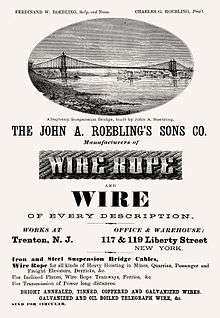
Roebling devised "an equilibrium strength approach, in which equilibrium is always satisfied but compatibility of deformations is not enforced." This was essentially an approximation method similar to the force method: First, Roebling computed the dead and live loads, then divided the load between the cables and the stays. Roebling added a large safety factor to the divided loads and then solved for the forces. This approach gave a sufficiently accurate analysis of the structure given the assumption that the structure was sufficiently ductile to handle the resulting deformation (Buonopane, 2006).
Roebling's company John A Roebling's Sons Co. is credited with being the cable contractor for the Golden Gate Bridge in San Francisco, California; constructed from 1933 to 1937. The Golden Gate Bridge was and still is a technical engineering marvel that Roebling, posthumously; has his footprint on.
Projects
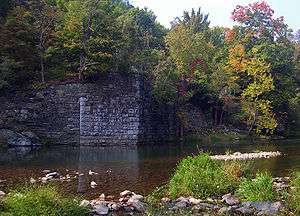
| Wikimedia Commons has media related to John A. Roebling. |
- c.1800s "The Shaky Bridge" near the Trenton Water Filtration Plant at the Calhoun Street Bridge (spans approx. 20 feet [6 m]) demonstration project[9]
- c.1800s "Demonstration Bridge" spans two buildings of the former Roebling Plant, Trenton, NJ. Now the Mercer County Executive Building on 175 South Broad Street Trenton NJ
- 1844 Allegheny Aqueduct Bridge – Pittsburgh; 162 feet (49 m) spans; demolished 1861
- 1846 Smithfield Street Bridge – Pittsburgh; 188 feet (57 m) spans; replaced 1881–1883
- 1848 Lackawaxen Aqueduct – spanning the Lackawaxen River at Lackawaxen, Pennsylvania; two spans of 115 feet (35m) each, two 7-inch (18 cm) cables; no longer extant
- 1849 Roebling's Delaware Aqueduct – spanning the Delaware River from Lackawaxen, Pennsylvania to Minisink Ford, New York, four spans of 134 feet (41 m) each, two 8-inch (20 cm) cables; converted to vehicular and pedestrian use, restored in 1965 and 1995
- 1850 High Falls Aqueduct – one span of 145 feet (44 m), two 8½-inch (22 cm) cables[10]
- 1850 Neversink Aqueduct – spanning the Neversink River; one span of 170 feet (52m), two 9½-inch (24 cm) cables
- 1854 Niagara Falls Suspension Bridge – spanning the Niagara River from Niagara Falls, New York to Niagara Falls, Canada, 821 feet (250 m) span
- 1859 Allegheny Bridge – Pittsburgh; 344-foot (105 m) spans
- 1866 John A. Roebling Suspension Bridge – spanning the Ohio River from Cincinnati, Ohio to Covington, Kentucky; 1,057 feet (322 m) long with a deck clearance of 100 feet (30 m)
- 1883 Brooklyn Bridge – spanning the East River from Manhattan to Brooklyn in New York City; 1,595 feet (486 m) span
- 1898 Ojuela Bridge (Puente de Ojuela) – suspension bridge at the site of the Ojuela Goldmine, Durango, Mexico; span of 271.5 metres
Honors
- In 2006, the Deutsche Post honored Roebling's 200th birthday with a stamp.
- Mühlhausen named the "John-August-Roebling-Schule" after him.
- In the sixth-season Brooklyn Nine-Nine episode "The Tattler," it's revealed that Jake and Gina attended John Roebling High School.
In popular culture
- Roebling makes a brief appearance in the opening scene of the 2001 romantic comedy Kate & Leopold, portrayed by actor and dialect coach Andrew Jack, who delivers Roebling's lines in a pronounced German accent. This is an anachronism, when the scene takes place in 1876, seven years after Roebling's death.
Personal life
Roebling was the youngest of four children. He was baptized in the Lutheran church Divi Blasii in Mühlhausen. As a young boy he played the bass clarinet and the french horn. He also exhibited great artistic talent for sketches and paintings. His father owned a small tobacco shop, but the business was insufficient to provide livelihood for all three sons. Roebling's sister Friederike Amalie married Carl August Meissner, a poor merchant in the town, and his oldest brother Herman Christian Roebling prepared to take over the tobacco shop.[11]
John Roebling and Johanna Herting had nine children:
- son: Washington Augustus Roebling (b. 1837, d. 1926)
- daughter: Laura R. Methfessel (b. 1840, d. 1873)
- son: Ferdinand William Roebling (b. 1842, d. 1917)
- daughter: Elvira R. Stewart (b. 1844, d. 1871)
- daughter: Josephine R. Jarvis (b. 1847,)
- son: Charles Gustavus Roebling (b. 9-Dec-1849, d. 1918)
- son: Edmund Roebling (b. 1854, d. 1930)
- son: William Elderhorst Roebling (b. 1856, d. 1860)
- daughter: Hannah Roebling (died in infancy)
Roebling's son Washington Roebling and his daughter-in-law Emily Warren Roebling continued his work on the Brooklyn Bridge. His son Ferdinand expanded his wire rope business. His son Charles Roebling designed and invented a huge 80 ton wire rope machine and founded the town of Roebling, New Jersey where the John A. Roebling's Sons company steel mill was built. His granddaughter Emily Roebling Cadwalader was a Philadelphia socialite noted as the owner of historic yachts. His grandson Washington A. Roebling II perished on the RMS Titanic. His great-grandson Donald Roebling was a noted philanthropist and inventor who devised the amphtrack. His great-great-grandson Paul Roebling was a well-regarded actor.
References
- "John A. Roebling, the Engineer". The New York Times. July 23, 1869. Retrieved 2015-11-09.
- Caso, Frank. "John Augustus Roebling." In Immigrant Entrepreneurship: German-American Business Biographies, 1720 to the Present, vol. 2, edited by William J. Hausman. German Historical Institute. Last modified May 15, 2014.
- Roebling, Washington A., Washington Roebling's Father, 2008, ASCE Press, Reston VA
- Güntherroth, Nele, Roebling's Development to Being an Engineer, 2006, Proceedings John A Roebling Symposium, ASCE, Reston VA
- Historic Saxonburg and Its Neighbors, Ralph Goldinger, ISBN 1-55856-043-2
- "National Register Information System". National Register of Historic Places. National Park Service. July 9, 2010.
- Steinman, David B. & Watson, Sara Ruth, Bridges and their Builders, 1941
- McCullough, David, The Great Bridge, 1982, p. 91
- "NJ DEP - Historic Preservation Office New Jersey and National Registers of Historic Places" (PDF). New Jersey Historic Preservation Office. p. 14. Archived from the original (PDF) on 16 May 2013. Retrieved 23 September 2016.
- D & H Canal Museum
- Schuyler, Hamilton, The Roeblings, 1931, p. 9, Princeton NJ
Further reading
- Buonopane, S. The Roeblings and the Stayed Suspension Bridge: Its Development and Propagation in 19th Century United States (2006)
- McCullough, David. The Great Bridge (Simon and Schuster, 1982)
- Reier, Sharon. The Bridges of New York (Dover, 2000)
- Sayenga, Donald. Washington Roebling's Father: A Memoir of John A. Roebling. Reston, Va.: American Society of Civil Engineers, 2009 ISBN 978-0-7844-0948-0
- Tolzmann, Don Heinrich. John A. Roebling and His Suspension Bridge on the Ohio River. Milford, Ohio: Little Miami Publishing Co., 2007
- Tolzmann, Don Heinrich. The Roebling Suspension Bridge: A Guide to Historic Sites, People, and Places. Cincinnati: Archivarium Press, 2017.
External links
| Wikimedia Commons has media related to John A. Roebling. |
- Invention Factory: Detailed biography
- John Augustus Roebling at Structurae
- John Roebling Historic Saxonburg Society

- Johnson, Rossiter (1879). . The American Cyclopædia.
- "Roebling, John Augustus". Appletons' Cyclopædia of American Biography. 1900.
- "Roebling, John Augustus". Encyclopædia Britannica (11th ed.). 1911.
